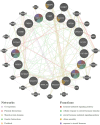Developmental Dyslexia: Insights from EEG-Based Findings and Molecular Signatures-A Pilot Study
- PMID: 38391714
- PMCID: PMC10887023
- DOI: 10.3390/brainsci14020139
Developmental Dyslexia: Insights from EEG-Based Findings and Molecular Signatures-A Pilot Study
Abstract
Developmental dyslexia (DD) is a learning disorder. Although risk genes have been identified, environmental factors, and particularly stress arising from constant difficulties, have been associated with the occurrence of DD by affecting brain plasticity and function, especially during critical neurodevelopmental stages. In this work, electroencephalogram (EEG) findings were coupled with the genetic and epigenetic molecular signatures of individuals with DD and matched controls. Specifically, we investigated the genetic and epigenetic correlates of key stress-associated genes (NR3C1, NR3C2, FKBP5, GILZ, SLC6A4) with psychological characteristics (depression, anxiety, and stress) often included in DD diagnostic criteria, as well as with brain EEG findings. We paired the observed brain rhythms with the expression levels of stress-related genes, investigated the epigenetic profile of the stress regulator glucocorticoid receptor (GR) and correlated such indices with demographic findings. This study presents a new interdisciplinary approach and findings that support the idea that stress, attributed to the demands of the school environment, may act as a contributing factor in the occurrence of the DD phenotype.
Keywords: HPA axis genes; developmental dyslexia; electroencephalogram; stress.
Conflict of interest statement
The authors declare no conflicts of interest.
Figures


Similar articles
-
Developmental Dyslexia: Environment Matters.Brain Sci. 2021 Jun 13;11(6):782. doi: 10.3390/brainsci11060782. Brain Sci. 2021. PMID: 34199166 Free PMC article.
-
Linking Early Life Hypothalamic-Pituitary-Adrenal Axis Functioning, Brain Asymmetries, and Personality Traits in Dyslexia: An Informative Case Study.Front Hum Neurosci. 2019 Oct 1;13:327. doi: 10.3389/fnhum.2019.00327. eCollection 2019. Front Hum Neurosci. 2019. PMID: 31632253 Free PMC article.
-
Peripheral DNA methylation of HPA axis-related genes in humans: Cross-tissue convergence, two-year stability and behavioural and neural correlates.Psychoneuroendocrinology. 2018 Nov;97:196-205. doi: 10.1016/j.psyneuen.2018.07.019. Epub 2018 Jul 27. Psychoneuroendocrinology. 2018. PMID: 30059826
-
Neurogenetics of developmental dyslexia: from genes to behavior through brain neuroimaging and cognitive and sensorial mechanisms.Transl Psychiatry. 2017 Jan 3;7(1):e987. doi: 10.1038/tp.2016.240. Transl Psychiatry. 2017. PMID: 28045463 Free PMC article. Review.
-
[Posttraumatic stress disorder (PTSD) as a consequence of the interaction between an individual genetic susceptibility, a traumatogenic event and a social context].Encephale. 2012 Oct;38(5):373-80. doi: 10.1016/j.encep.2011.12.003. Epub 2012 Jan 24. Encephale. 2012. PMID: 23062450 Review. French.
References
-
- Elliott J.G., Grigorenko E.L. The Dyslexia Debate. Cambridge University Press; Cambridge, UK: 2014.
LinkOut - more resources
Full Text Sources
Miscellaneous

